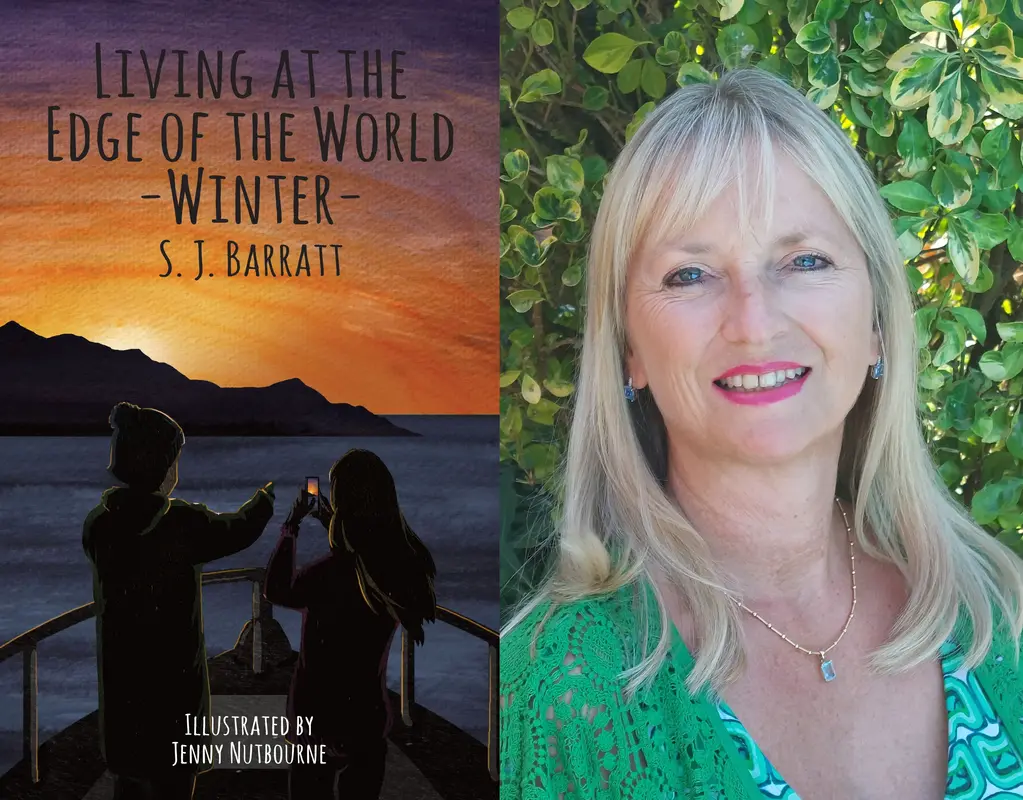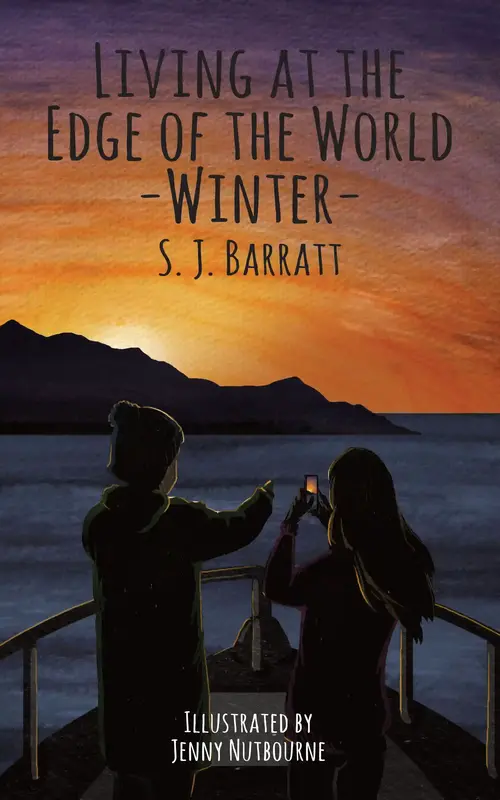This post may contain affiliate links. Read more here.

If you have a passion for captivating children’s stories, then you’re in for a treat. ✨
Suzanne Barratt’s first book, Living at the Edge of the World, is a children story that intertwines nature and wildlife with contemporary urban themes. Set to be released on December 10th, it draws inspiration from the Shetland landscapes, specifically the intriguing island of Foula.
In a world increasingly dominated by digital screens, Suzanne emphasizes the importance of connecting children with nature and an outdoor lifestyle in this interview.
Living at the Edge of the World – Winter by S. J. Barratt
Q: Your love for reading and storytelling is evident in your work. How did your childhood experiences with reading clubs and visits to the library influence your decision to become an author?
A: I have always been a bookworm, especially growing up. Very shy and introverted I was happy to loose myself in stories. When I did make friends, they were often organized into “reading clubs” where we would sit and read in companionable silence!
When a teenager I was asked to review books for the local library, a constructive outlet for all my reading time! Looking at career options, I did want to be a journalist at first but I got put off by the idea that you have to be cut throat and relentless in the pursuit of a good story.
A children’s author is more my genteel cup of tea! Creating characters that resonate with visionary inspirational worlds that can help youngsters grow into interesting adults is more my thing.
Q: ‘Living at the Edge of the World – Winter’ takes place in the remote island of Papala. Can you tell us more about the inspiration behind this fictional island and its connection to the Shetland landscapes?
A: Yes the inspiration first came from reading about the Shetland island Foula, which I found fascinating. One of the most remote islands in the archipelago, where only 30 people live and is also known as the bird island.
I shared my first draft actually with one of the rangers on Foula last winter for feedback and she was a wonderful correspondent throughout the winter months, answering my numerous questions about the fauna and flora of the remote, ragged landscape she has called home for a number of years.
Q: Shetland seems to hold a special place in your heart. Can you share a specific experience or moment from your time there that left a lasting impression on you and inspired elements in your book?
A: My son and I went hunting for the aurora borealis in Shetland last year and traveled across the mainland and the islands Yell and Unst in hot pursuit.
We were not lucky enough to see the northern lights or the “pretty dancers” as they call them on Foula, but every day the skies were beautiful… Sunsets, rainbows and fascinating cloud formations. Seeing otters play on the coastline in Yell or climbing into a Viking boat on Unst – there is much to inspire a budding author.
Q: Your book explores the theme of embracing nature and the unfamiliar. In today’s digital age, why do you think it’s important for children to connect with nature and experience an outdoor lifestyle?
A: I have always been curious about different cultures and lifestyles as you can learn so much about human nature and expand your mind. I see so many children these days glued to their phones, not communicating and not experiencing life to the full.
I thought it would be interesting to contrast the two mindsets – a digital influencer lifestyle with remote living and see what comes out! The mix is my main character Tabitha… but you will have to read the story to find out what happens to her when the two worlds collide!
Q: The protagonist, Tabitha, is frustrated with the island’s isolation, while Timothy is fascinated by its natural secrets. How do these contrasting perspectives reflect the broader theme of adapting to new environments and finding joy in unexpected places?
A: The twins have completely different characters and interests but they do respect each other. Timothy due to his interest in nature and the environment finds it easier to adapt to a remote lifestyle. But Tabitha does find her niche and a mission that enables her to consolidate both her love for social media and discovering the new elements of island life.
Q: You mentioned teaching storytelling to Business master’s degree students. How does your teaching experience influence your approach to crafting narratives in your books?
A: As we know telling stories is an art and one that takes time to perfect. Many business students are so concentrated on dumping information on their unfortunate audience, that they forget to be themselves and create a human narrative that will hook us into their messaging with a lasting impression.
I try to practice what I preach when writing stories with a vertical take off, sensory imagery and interesting characterization to make the story compelling to readers… But as we know storytelling is often work in progress – always room for improvement!
Q: Your book emphasizes courage, friendship, and the joy of embracing the unfamiliar. Can you share a pivotal moment in the story where these themes come together, and how it resonates with your own beliefs about friendship and exploration?
A: The final chapter really is where these themes come together as the three children are faced with a pivotal moment where the protagonist is courageous but puts herself and the other two children in danger. You are going to have to read the book to know how it turns out!
As a teaser, there are many Vikings involved in the scenario and a burning boat….
Q: Could you tell us more about the collaboration with Jenny Nutbourne, the illustrator of ‘Living at the Edge of the World – Winter’? How did the illustrations enhance the storytelling process?
A: Jenny is a very talented young illustrator, living and working currently in Scotland. She attended Dundee University where my son is studying currently, which is the connection. I am a very visual person and any project that I undertake I do like to work with images. Rather than write pages about my characters I try to find an image of them for inspiration purposes.
Jenny worked with me as I was creating the first draft, drawing the maps of the island which helped me visualize first Foula, then the imaginary island Papala. You can see both her creations in the book as the two main characters have drawn the island from different perspectives. Tabitha with an interest in WiFi and the landscape and Timothy with insight into the birds and animals.
In every chapter, Jenny has really brought the book to life with her illustrations. When the book is published and selling well, I would also like to see her drawings on objects too…. A “selkie*” on a silk scarve…. A “skekler*” on a mug… as the world needs to see her talent! *Read the book to find out what a Selkie and a Skekler are!!
Q: As an indie-author, what challenges have you faced in the publishing industry, and how have you overcome them? Do you have any advice for aspiring authors who are considering self-publishing their work?
A: This first book has been a learning journey for me – not just to Shetland and back, but also backwards and forwards in the publishing industry.
When I set out I did not realize how competitive writing for children was and how “vanity publishers” can ambush you at every step and turn. At first, I did not know how to get professional editing advice other than querying publishing houses or agents.
My main decision to self publish was because I wanted full creative control. Delighted with Jenny’s creative illustrations, I did not want an editor to choose who and how the story should be illustrated.
Discovering the site Reedsy gave me access to a whole host of professionals which really helped with the editing process and gave me confidence to self-publish.
Q: Lastly, what can readers expect from the next installment in the series? Any hints or teasers you can share about the upcoming adventures of Tabitha and Timothy?
A: The next book is Living at the edge of the World – Spring. The twins are still on the island, embarking on daily adventures immersed in the spectacle of mating birds and the wonder of lambing season – worlds apart from bustling London.
For the young reader it is a chance to dive headlong into the natural and ecological world of Papala in a compelling way, following the antics of the twins Tabitha and Timothy and their friends Fenella and Omar.
The end of the book finds the twins back in London with their parents far from nature and this is where the story should end, but will it?
For more with Suzanne, make sure to follow her newsletter, or follow her on social media.
Happy reading! ❤️
